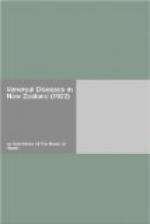The Conference found that venereal diseases are the most potent of all causes of sterility and of infant and foetal morbidity and mortality. It recommended, among other remedial measures, that prophylactic depots, both for males and females, should be established as widely in the community as possible. Referring to the educational aspect, the Conference urged that children should be instructed in general biological facts up to the age of puberty, when more explicit information concerning facts of sexual life should be given. They urged on all parents and educational, philanthropic, and religious organizations the pressing necessity for a sustained campaign, in co-operation with the medical profession, in order to inculcate in the community higher ideals of personal hygiene and health.
Lastly, it may be mentioned that, at the instance of Lord Dawson of Penn, a highly qualified and representative committee of medical men, with Lord Trevethin as chairman, has been appointed in England to report to the Minister of Health upon “the best medical measures for preventing venereal disease in the civil community, having regard to administrative practicability, including cost.” The appointment of such a committee was requested by Lord Dawson chiefly with a view to obtaining an authoritative pronouncement on the subject of medical preventive measures, and the committee’s report will be awaited with much interest.
SECTION 5.—LEGISLATION IN NEW ZEALAND, PAST AND PRESENT.
(A) Contagious Diseases Act (repealed).
The Contagious Diseases Act was passed in 1869, and repealed in 1910. Briefly, its aim was to secure periodical examinations of prostitutes, and to detain for treatment those prostitutes found infected with venereal disease.
There appears to be, in some quarters, an apprehension that hidden beneath the movement to combat venereal diseases is an implied desire or intention to reinstate the antiquated and detested provisions of that Act. The Committee deem it necessary to say that they have not found grounds for this suspicion; that no legislation can be effective unless it deals equally and adequately with all men, women, and children sufferers from venereal diseases of all kinds; that it finds little evidence of a definite prostitute class in New Zealand, and, even if there were such, the Contagious Diseases Acts have been proved to be useless as measures towards the prevention of venereal infections; and it is the Committee’s individual and collective opinion that anything involving a return to the administrative procedure of the Contagious Diseases Act should have no part whatever in any new legislation in this Dominion.
(B.) Examples of Difficulties—Concrete Cases.
Before proceeding to refer to present and suggested legislation, a few incidents and cases taken from the evidence may help, as concrete examples, to indicate the difficulties to be contended with:—




